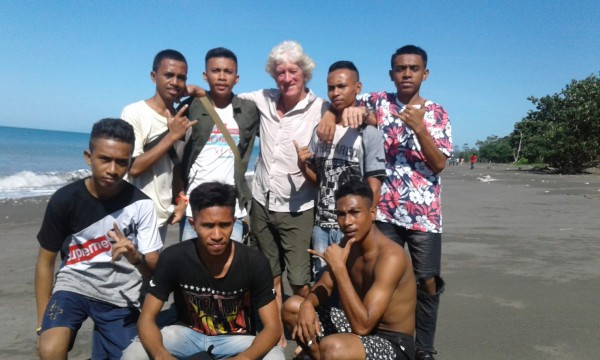Meet VSA volunteer Barry Binding, who has been with us since 2008. Barry's first assignment was in Bougainville for two years, where he later returned to pick up three additional assignments for another two years. This was then followed by a short-term project in Vanuatu, and finally a one-year assignment in Timor-Leste. Barry’s partner, Joanne Trimble, accompanied him during his many assignments in Bougainville and Timor-Leste. Over these ten years, Barry has undertaken core tasks with our partner organisations that range from building a library to assessing damage to employee housing post-Vanuatu’s devastating cyclone. Here’s a peek into Barry’s time as a volunteer in the Pacific…
Give us an insight into your first assignment in Bougainville.
My first assignment in Bougainville was in 2008 with the Arawa Carpentry and Social Development Association. Arawa Carpentry’s ultimate goal was to achieve independence from funding and run unassisted. My goal was to help them achieve this, alongside lifting their quality level and training the tutors to teach to a higher level. I had two main tutors and around twenty-five students. This was a great high for me, I loved Bougainville and its people. I feel privileged to have been part of their achievement.
What brought you back to Bougainville?
I received the opportunity to work on three assignments between 2011 to 2013 in Bougainville. The assignments were to cover the building of the Bougainville Library and Cultural Centre based in Arawa. The partner organisation was the BHF Bougainville Heritage Foundation and New Zealand partner BLT Bougainville Library Trust. BHF's goal was to build a library and cultural centre for all the people of Bougainville to have access to. My role was to make this happen. The BLT New Zealand was set up by Lloyd Jones (the author of the novel Mister Pip) and like-minded people to raise funds to pay for the building costs including an art sale at the Government House in Wellington. This project gave me a great opportunity to go back to Bougainville. It also allowed me to engage as many locals as I could for the build which was a good way of giving ownership to everyone involved. I organised a container from New Zealand with all the hardware roofing iron and other essentials. The main workforce was from Arawa carpentry as they had the skills for this build. All timber was sourced locally. To my dismay, the container got stuck in Lae (PNG) on the wharf for five and a half months. This was a fantastic assignment, and the end product was amazing for Bougainville. My biggest high was finally getting the container released and arriving in Keita. It was a miracle it arrived intact - the locks had been forced but not quite opened. The next high for me was the official opening of the building in the presence of Lloyd Jones and others involved with the BLT.
What have you enjoyed most about your time in Bougainville?
The thing I enjoyed most about being in Bougainville was the simple island lifestyle. The local markets were fantastic with plenty of fresh produce. I loved the people and being involved with them on a day-to-day basis. Bougainvilleans are people who have little yet have so much. Bougainville is beautiful and has amazing thunderstorms.

What was your next assignment with us?
My next assignment was in Vanuatu in 2015 as the Building Project Scoping Adviser. My role was to document the damage to employee housing after the devastating cyclone Pam. My partner organisation at the time was going to be Digicel Vanuatu. The assignment was to document damage to twenty-six employee houses and to quantify material and labour costs to repair or rebuild. The cost of building two daycare centres had to be assessed as well. Unfortunately, the project had to be closed early for internal reasons. As such, my time in Vanuatu was short, but again, Ni-Vanuatu are lovely people, and the town has great markets for fresh produce.
What was your role in Timor-Leste?
I was in Timor-Leste in 2018 with the Claret Training Centre (CTC) in Salele Suai, a very isolated part of Timor. It was run by Father Juan Angel Artiles Roberto. We lived on the school grounds along with about one hundred live-in students. Their goal was to achieve a higher teaching standard for their tutors. The school had classes for Carpentry, plumbing, electrics, welding and bricklaying. My role was to tutor the tutors to obtain a higher level of teaching as they were only teaching up to level one. It was quite a hard assignment as none of the tutors were fluent in English. I taught with the aid of a dictionary and the Tetun app. We managed very well and got better each day with the help of Father Juan. I achieved my goals and the teachers moved on to teaching level two, which was a big win for me. I also started teaching English after work and one day on the weekends. I still keep in touch with some students and tutors, and of course, Father Juan, and I hope to visit them later in the year. The Timorese are beautiful gentle people and I very much enjoyed working with them. On Sunday mornings, the locals walked for miles for the morning mass dressed amazingly—it was fantastic to witness. I would go back to any of these places in an instant.
What advice would you give to those considering a volunteering assignment in the Pacific?
My advice for anyone going on an assignment to the Pacific is to go with an open mind. Things may not always work out the way you expect or in your time, so don’t expect that you can make it happen. It’s done in their time. Most assignments evolve once in-country and are not totally to script. I think it is best to go slow and observe for the first week to get the feel of your assignment.
